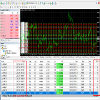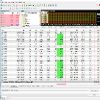Edit Your Comment
EUR/USD
会员从Dec 21, 2023开始
48帖子
May 03, 2024 at 07:43
会员从Dec 21, 2023开始
48帖子
USD: Payrolls may finally start softening
The post-FOMC bias has been markedly bearish on the dollar, and despite the US payrolls risk event today, markets have continued to squeeze USD long positioning yesterday and overnight. The yen remains a major contributor to the soft dollar momentum. Earlier this week, we noted how USD/JPY was showing the same kind of dynamics around and straight after FX intervention in September 2022, when the pair had steadily ground higher in the period after Japan intervened to support the yen. However, the second round of JPY intervention in one week, deployed after a less hawkish than expected FOMC on Wednesday, has sent markets the message that the Ministry of Finance is less tolerant of a post-intervention depreciation of the yen this time. With the help of a rally in short-term USD swaps, USD/JPY is trading just below 153 this morning, around 4.5% below its 160 peak on Monday.
Today’s US payrolls are a huge event for markets, as the details in the jobs report will be a key test to more optimistic bets on Fed rate cuts after Chair Jerome Powell defied the hawkish repricing of the USD curve. Fed funds futures are now again pricing in a rate cut in November, with the September contract showing -20bp and the July one -10bp. The dollar 2-year swap rate is down to 4.80% from 4.95% pre-FOMC, and applying material downside pressure on the dollar.
The consensus for today’s April nonfarm payroll print is 240k, and our call is 210k. The unemployment rate is expected to remain at 3.8%. We note that – despite the continued strength in the latest payroll prints – business surveys still point to a substantial slowing in employment. One of those surveys is the ISM, whose services component is also released this afternoon and expected to come in at 52.0, up from 51.4 in March.
Like in previous jobs releases, the discussion around data quality will be central. The payroll survey has continued to give contrasting indications to the household employment data, which has been much weaker since 4Q23. The household survey is thought to be missing a proper adjustment for rising immigration in the US, essentially underestimating the total workforce and showing inaccurately lower unemployment rates. On the other hand, payrolls may be doing some double counting as the number of Americans holding multiple jobs is at a 30-year high and the birth-death adjustment is generally considered to be pumping up the jobs figures. A convergence of any of those series towards the other would be a crucial development in the coming months.
All in all, our 210k call for payrolls means we do not expect today’s data to dent the bearish dollar momentum as markets may fully price in a cut in September and keep short-term USD rates capped. CFTC data shows net-speculative positioning on the dollar versus reported G10 currencies was at 24% of open interest, the highest since June 2019, so the room for a further long squeeze in the dollar remains substantial should US data soften over the coming weeks.
The post-FOMC bias has been markedly bearish on the dollar, and despite the US payrolls risk event today, markets have continued to squeeze USD long positioning yesterday and overnight. The yen remains a major contributor to the soft dollar momentum. Earlier this week, we noted how USD/JPY was showing the same kind of dynamics around and straight after FX intervention in September 2022, when the pair had steadily ground higher in the period after Japan intervened to support the yen. However, the second round of JPY intervention in one week, deployed after a less hawkish than expected FOMC on Wednesday, has sent markets the message that the Ministry of Finance is less tolerant of a post-intervention depreciation of the yen this time. With the help of a rally in short-term USD swaps, USD/JPY is trading just below 153 this morning, around 4.5% below its 160 peak on Monday.
Today’s US payrolls are a huge event for markets, as the details in the jobs report will be a key test to more optimistic bets on Fed rate cuts after Chair Jerome Powell defied the hawkish repricing of the USD curve. Fed funds futures are now again pricing in a rate cut in November, with the September contract showing -20bp and the July one -10bp. The dollar 2-year swap rate is down to 4.80% from 4.95% pre-FOMC, and applying material downside pressure on the dollar.
The consensus for today’s April nonfarm payroll print is 240k, and our call is 210k. The unemployment rate is expected to remain at 3.8%. We note that – despite the continued strength in the latest payroll prints – business surveys still point to a substantial slowing in employment. One of those surveys is the ISM, whose services component is also released this afternoon and expected to come in at 52.0, up from 51.4 in March.
Like in previous jobs releases, the discussion around data quality will be central. The payroll survey has continued to give contrasting indications to the household employment data, which has been much weaker since 4Q23. The household survey is thought to be missing a proper adjustment for rising immigration in the US, essentially underestimating the total workforce and showing inaccurately lower unemployment rates. On the other hand, payrolls may be doing some double counting as the number of Americans holding multiple jobs is at a 30-year high and the birth-death adjustment is generally considered to be pumping up the jobs figures. A convergence of any of those series towards the other would be a crucial development in the coming months.
All in all, our 210k call for payrolls means we do not expect today’s data to dent the bearish dollar momentum as markets may fully price in a cut in September and keep short-term USD rates capped. CFTC data shows net-speculative positioning on the dollar versus reported G10 currencies was at 24% of open interest, the highest since June 2019, so the room for a further long squeeze in the dollar remains substantial should US data soften over the coming weeks.
May 24, 2024 at 15:36
会员从May 24, 2024开始
43帖子
LinoCapital posted:
USD: Payrolls may finally start softening
The post-FOMC bias has been markedly bearish on the dollar, and despite the US payrolls risk event today, markets have continued to squeeze USD long positioning yesterday and overnight. The yen remains a major contributor to the soft dollar momentum. Earlier this week, we noted how USD/JPY was showing the same kind of dynamics around and straight after FX intervention in September 2022, when the pair had steadily ground higher in the period after Japan intervened to support the yen. However, the second round of JPY intervention in one week, deployed after a less hawkish than expected FOMC on Wednesday, has sent markets the message that the Ministry of Finance is less tolerant of a post-intervention depreciation of the yen this time. With the help of a rally in short-term USD swaps, USD/JPY is trading just below 153 this morning, around 4.5% below its 160 peak on Monday.
Today’s US payrolls are a huge event for markets, as the details in the jobs report will be a key test to more optimistic bets on Fed rate cuts after Chair Jerome Powell defied the hawkish repricing of the USD curve. Fed funds futures are now again pricing in a rate cut in November, with the September contract showing -20bp and the July one -10bp. The dollar 2-year swap rate is down to 4.80% from 4.95% pre-FOMC, and applying material downside pressure on the dollar.
The consensus for today’s April nonfarm payroll print is 240k, and our call is 210k. The unemployment rate is expected to remain at 3.8%. We note that – despite the continued strength in the latest payroll prints – business surveys still point to a substantial slowing in employment. One of those surveys is the ISM, whose services component is also released this afternoon and expected to come in at 52.0, up from 51.4 in March.
Like in previous jobs releases, the discussion around data quality will be central. The payroll survey has continued to give contrasting indications to the household employment data, which has been much weaker since 4Q23. The household survey is thought to be missing a proper adjustment for rising immigration in the US, essentially underestimating the total workforce and showing inaccurately lower unemployment rates. On the other hand, payrolls may be doing some double counting as the number of Americans holding multiple jobs is at a 30-year high and the birth-death adjustment is generally considered to be pumping up the jobs figures. A convergence of any of those series towards the other would be a crucial development in the coming months.
All in all, our 210k call for payrolls means we do not expect today’s data to dent the bearish dollar momentum as markets may fully price in a cut in September and keep short-term USD rates capped. CFTC data shows net-speculative positioning on the dollar versus reported G10 currencies was at 24% of open interest, the highest since June 2019, so the room for a further long squeeze in the dollar remains substantial should US data soften over the coming weeks.
I am a financial strategist, pay attention to the actual research of risk control management strategy, do not talk about lofty theory, only pursue in practice, the most pragmatic and feasible trading strategy, so the general conclusion of the "0.01 each time under the single" war method, for your reference. Over the years, I have repeatedly talked about it, but the response is few, and perhaps even fewer are willing to practice in the real plate. But I have broken the Guinness Book of Records in the financial world through this trading rule!!!
Therefore, I basically do not consider the influence of the world situation and policies, and I hope to communicate with like-minded friends.
会员从Mar 30, 2018开始
3帖子
Jun 07, 2024 at 17:14
(已编辑 Jun 07, 2024 at 17:16)
会员从Mar 30, 2018开始
3帖子
Hello, I have been working on buying on forex news for almost a year and I came to the conclusion that no progress can be made with this method. There was no incense
With 10 years of experience in the forex market, this method was not useful. There was a time when I was working on cot Data and it did not make all the progress
With 10 years of experience in the forex market, this method was not useful. There was a time when I was working on cot Data and it did not make all the progress
会员从Mar 30, 2018开始
3帖子
Jun 10, 2024 at 07:22
会员从May 24, 2024开始
43帖子
asghar1234 posted:
Hello, I have been working on buying on forex news for almost a year and I came to the conclusion that no progress can be made with this method. There was no incense
With 10 years of experience in the forex market, this method was not useful. There was a time when I was working on cot Data and it did not make all the progress
We are the first person to challenge the Guinness World Record in finance with a 100% success rate of 10,000 transactions in 100 days.
Record: From May 2, 2022 to September 15, 2022, there were a total of 99 trading days. The gold variety stopped at 47 trading days, with a total of 4068 transactions and blew up.
Jun 12, 2024 at 17:05
会员从May 24, 2024开始
43帖子
UPUPEA posted:asghar1234 posted:
Using the robot is much more practical and logical, even if a little weak martingale is used, including martingale roulette
I did achieve a steady profit with my trading ideas, so automated tools and some ideas are trustworthy
This is my most recent record,You can go three months without checking any news and be 100% profitable
Jun 28, 2024 at 21:15
会员从Feb 12, 2016开始
133帖子
stevewalker posted:
for last 2-3 months ( heavly) market only trading news. and there are enough news actually. even on weekend or at asian session.
robots/EA s R.I.P.
Big one move with actual news then stop/consolidation until next news.
walker
Can you suggest any efficient and profitable bot for news trading. Btw I trade with HFM is it good for news trading?
会员从Mar 16, 2022开始
6帖子
Jul 06, 2024 at 08:07
会员从Mar 16, 2022开始
6帖子
I coded may news trading EAs.
Idea 1)
open Buy stop and Sell stop 5 min before news are launched. When price moves after the news, one of these 2 trades is triggered
Idea 2)
after the news is released, wait 15 minutes and open a trade within new trend (if price went up after the news, open Buy trade)
Unfortunatelly none of these 2 bots were profitable because I was not able to set correct TP and SL. It should be set differently for NFP, inlation, unemployment rate decisions etc. For profitable trading you should analyze average move after that kind of news.
Idea 1)
open Buy stop and Sell stop 5 min before news are launched. When price moves after the news, one of these 2 trades is triggered
Idea 2)
after the news is released, wait 15 minutes and open a trade within new trend (if price went up after the news, open Buy trade)
Unfortunatelly none of these 2 bots were profitable because I was not able to set correct TP and SL. It should be set differently for NFP, inlation, unemployment rate decisions etc. For profitable trading you should analyze average move after that kind of news.
会员从May 19, 2023开始
294帖子
Jul 07, 2024 at 09:36
会员从May 19, 2023开始
294帖子
Petr_Nemec posted:
I coded may news trading EAs.
Idea 1)
open Buy stop and Sell stop 5 min before news are launched. When price moves after the news, one of these 2 trades is triggered
Idea 2)
after the news is released, wait 15 minutes and open a trade within new trend (if price went up after the news, open Buy trade)
Unfortunatelly none of these 2 bots were profitable because I was not able to set correct TP and SL. It should be set differently for NFP, inlation, unemployment rate decisions etc. For profitable trading you should analyze average move after that kind of news.
Expert advisors like this, don't need a TP and SL, you must use a Trailing and account must be with fixed spread.
Because it is not about what type of news is coming out, but depend how strong it is, some times there is almost no move on NonFarm, sometimes it get huge move.
So my recommendation is exclude fixed TP, and start use Trailing Stop.
Jul 11, 2024 at 06:17
会员从May 24, 2024开始
43帖子
RobotForexProEA posted:Petr_Nemec posted:
I coded may news trading EAs.
Idea 1)
open Buy stop and Sell stop 5 min before news are launched. When price moves after the news, one of these 2 trades is triggered
Idea 2)
after the news is released, wait 15 minutes and open a trade within new trend (if price went up after the news, open Buy trade)
Unfortunatelly none of these 2 bots were profitable because I was not able to set correct TP and SL. It should be set differently for NFP, inlation, unemployment rate decisions etc. For profitable trading you should analyze average move after that kind of news.
Expert advisors like this, don't need a TP and SL, you must use a Trailing and account must be with fixed spread.
Because it is not about what type of news is coming out, but depend how strong it is, some times there is almost no move on NonFarm, sometimes it get huge move.
So my recommendation is exclude fixed TP, and start use Trailing Stop.
Everything went well with today's results

*商业用途和垃圾邮件将不被容忍,并可能导致账户终止。
提示:发布图片/YouTube网址会自动嵌入到您的帖子中!
提示:键入@符号,自动完成参与此讨论的用户名。






_24-05-03_15-16-12.png)











